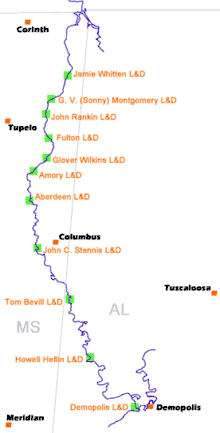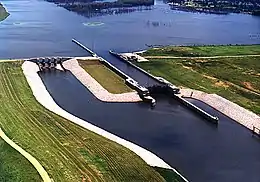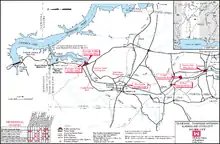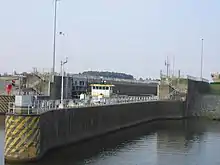Tennessee–Tombigbee Waterway
The Tennessee–Tombigbee Waterway (popularly known as the Tenn-Tom) is a 234-mile (377 km) man-made U.S. waterway built in the 20th century from the Tennessee River to the junction of the Black Warrior-Tombigbee River system near Demopolis, Alabama. The Tennessee–Tombigbee Waterway links commercial navigation from the nation's midsection to the Gulf of Mexico. The major features of the waterway are 234 miles (377 km) of navigation channels, a 175-foot-deep (53 m) cut between the watersheds of the Tombigbee and Tennessee rivers, and ten locks and dams.[1] The locks are 9 by 110 by 600 feet (2.7 m × 33.5 m × 182.9 m), the same dimension as those on the Mississippi above Lock and Dam 26 at Alton, Illinois.[2][3] Under construction for 12 years by the U.S. Army Corps of Engineers, the Tennessee–Tombigbee Waterway was completed in December 1984 at a total cost of nearly $2 billion.[4]

The Tenn-Tom encompasses 17 public ports and terminals, 110,000 acres (450 km2) of land, and another 88,000 acres (360 km2) managed by state conservation agencies for wildlife habitat preservation and recreational use.[4]
Early history and construction
First proposed in the Colonial period, the idea for a commercial waterway link between the Tennessee and Tombigbee rivers did not receive serious attention until the advent of river steamboat traffic in the early nineteenth century. It stimulated trade throughout the river cities, and the ability to get products to the Gulf Coast for overseas shipping. As steamboat efficiency gains caused water transport costs to decline, in 1875 engineers surveyed a potential canal route for the first time.[5] They issued a negative report, emphasizing that prohibitive cost estimates kept the project from economic feasibility.[5]
Enthusiasm for the project languished until the presidency of Franklin D. Roosevelt, who took office during the Great Depression and quickly conceived of investment in major infrastructure projects to put many of the unemployed to work. The development of the Tennessee River by the TVA, especially the construction of the Pickwick Lock and Dam in 1938, helped decrease the Tenn-Tom's potential economic costs and increase its potential benefits. Pickwick Lake's design included an embayment on its south shore at Yellow Creek, which would permit the design and construction of an entrance to a future southward waterway (leading to the Tombigbee River), should it be decided that such a waterway should be built in the future.
Later, construction (under World War II emergency authorization) of Kentucky Dam at Gilbertsville, Kentucky, near the mouth of the Tennessee River's confluence with the Ohio River, would complete the "northern" half of the future waterway.[5] As early as 1941 the proposal was combined with those for other waterways, such as the St. Lawrence Seaway, with the aim of building broader political support.[6] Additionally, political candidates in the South began to favor construction of the waterway for political reasons, that is, in order to appeal to their voters, rather than for economic reasons. In this period, most blacks in the South were still disenfranchised; the waterway was conceived as benefitting white businessmen and only southern white conservatives were voting on these proposals from that region. In the early 1960s it was proposed that the canal could be created by use of atomic blasts.[7]
As part of his "Southern Strategy" for election, Republican President Richard Nixon committed to the project. He included $1 million in the Corps of Engineers' 1971 budget to start construction of the Tenn-Tom.[8] Funding shortages and legal challenges delayed construction until December 1972, but Nixon's efforts initiated official Tenn-Tom waterway construction.[8]
The U.S. Army Corps of Engineers began work on the project in 1972. During the construction process, land excavation reached about 175 feet (53 m) in depth and required the excavation of nearly 310 million cubic yards of soil (the equivalent of more than 100 million dump truck loads). The project was completed on December 12, 1984, nearly two years ahead of schedule.[9]
Controversy
The $2 billion in required funding for the Tenn-Tom waterway was repeatedly attacked by elected representatives and political organizations. Opponents asserted that the estimated economic benefits of the waterway by the Corps of Engineers were unsupportable based on projected traffic volume. The waterway's essential economic rationales—that it would generate a demand for industries to locate along its banks, and use its barge handling capacity— were not realized (as its critics had correctly predicted). The growth in traffic volume on the existing Missouri – Ohio – Mississippi waterway did not require the second, parallel route (the Tenn-Tom), between Cairo, Illinois, and the Gulf of Mexico. Immediately after his election in 1976, Democratic President Jimmy Carter announced a plan to slash Tenn-Tom federal funding. He was seeking to balance federal spending after high expenditures for years over the Vietnam War.
By 1977, the Tenn-Tom was one of many such Corps of Engineers projects that had been initiated on the dubious rationale that they would somehow directly or indirectly return to the Treasury their cost(s) of construction. Carter, and the economic advisors recruited to his administration, objected not only to the "waste" of taxpayer dollars on pork-barrel projects; they strongly disapproved of the distortions in investment that such expenditures caused within the "real" economy.[8] But, after more than 6,500 waterway supporters attended a public hearing held in Columbus, Mississippi, as part of Carter's review of the proposed waterway, the President withdrew his opposition.[8]
The Louisville and Nashville Railroad filed a series of lawsuits to halt construction of the waterway.[10] Railroad companies, which served as a major transport alternative to river traffic and stood to potentially lose the most value from construction of the waterway, asserted that its construction violated the National Environmental Policy Act.[10] Federal courts ruled in favor of the project.[10]
The waterway carried 7 million tons of cargo in 2004, the Tuscaloosa News reported on January 9, 2005, commemorating the canal's 20th anniversary.[2] Proponents of the canal had projected that it would carry 28 million tons in its first year and 99 million tons annually by 2035. For comparison, the Mississippi River system carried 307 million tons of cargo in 2004.
Economic effects
When completed, the Tenn-Tom waterway's total cost was $1.992 billion, including non-federal costs. Some political and economic commentators derided the project as "pork-barrel politics at its worst".[5] For the first few years after its completion, such criticism appeared valid. The Tennessee–Tombigbee Waterway had opened in the midst of an economic recession in the barge business, which resulted in initially disappointingly low use of the waterway.[10]
The 1988 drought, however, closed the Mississippi River and shifted traffic to the Tenn-Tom canal.[8] This coincided with an economic turnaround on the Tennessee-Tombigbee corridor, wherein trade tonnage and commercial investment increased steadily over several years.
The two primary commodities shipped via the Tenn-Tom are coal and timber products, together comprising about 70 percent of total commercial shipping on the waterway.[11] The Tenn-Tom also provides access to over 34 million acres (140,000 km2) of commercial forests and approximately two-thirds of all recoverable coal reserves in the nation. Industries that use these natural resources have found the waterway to be their most cost-efficient mode of transportation.[11] Other popular trade products carried on the Tenn-Tom include grain, gravel, sand, and iron.
A 2009 study by Troy University found that the waterway had contributed nearly $43 billion in direct, indirect, and induced economic benefits to the United States, including the direct creation of more than 29,000 jobs,[11] and was replacing an annual average of 284,000 truckloads.[11]
Divide Cut

The Divide Cut (34°55′0″N 88°14′31″W) is a 29 mi (47 km) canal that makes the connection to the Tennessee River. It connects Pickwick Lake on the Tennessee to Bay Springs Lake, at Mississippi Highway 30. The cut carries the waterway between the Tennessee River watershed, which eventually empties into the Ohio River, and the Tombigbee River watershed, which eventually empties into the Gulf of Mexico at Mobile.
Pickwick Lake is a popular location for water sports such as waterskiing and wakeboarding.
For construction of the Divide Cut, the entire town of Holcut, Mississippi, had to be removed and demolished. Today, the Holcut Memorial lies alongside the waterway on the previous site of the town.
Locks and dams
The waterway is composed of ten locks (listed below from north to south along the waterway); many are named after Southern politicians who supported the project:
- Jamie Whitten Lock and Dam; formerly named Bay Springs Lock and Dam – impounds Bay Springs Lake 34°31′20″N 88°19′30″W
- G. V. Montgomery Lock; formerly named Lock E 34°27′47.06″N 88°21′53.5″W
- John Rankin Lock; formerly named Lock D 34°21′47.1″N 88°24′28.23″W
- Fulton Lock; located in Fulton, Mississippi, formerly named Lock C 34°15′28″N 88°25′29″W
- Glover Wilkins Lock; located in Smithville, Mississippi, formerly named Lock B 34°3′53.54″N 88°25′33.19″W
- Amory Lock; located in Amory, Mississippi, formerly named Lock A 34°00′40″N 88°29′21″W
- Aberdeen Lock and Dam; located in Aberdeen, Mississippi – impounds Aberdeen Lake 33°49′50″N 88°31′11″W
- John C. Stennis Lock and Dam; formerly named Columbus Lock and Dam – impounds Columbus Lake 33°31′5″N 88°29′20″W
- Tom Bevill Lock and Dam; formerly named Aliceville Lock and Dam – impounds Aliceville Lake 33°12′38″N 88°17′16″W
- Howell Heflin Lock and Dam; formerly named Gainesville Lock and Dam – impounds Gainesville Lake 32°50′12.86″N 88°8′8.73″W
Gallery
 The Divide Cut under construction in the early 1980s
The Divide Cut under construction in the early 1980s Amory Lock at Amory, Mississippi
Amory Lock at Amory, Mississippi An Illinois Central Railroad (IC) bridge over the waterway at mile 424.8
An Illinois Central Railroad (IC) bridge over the waterway at mile 424.8 Detailed map of the Divide Cut (Corps of Engineers)
Detailed map of the Divide Cut (Corps of Engineers)
Notes
- "Tenn-Tom Waterway Key Components". 2009. Tennessee-Tombigbee Waterway Development Authority. Available at <http://www.tenntom.org/about/ttwkeycomponents.htm>.
-
Johnny Kampis (January 9, 2005). "20-year anniversary of Tennessee-Tombigbee Waterway: Canal's success debated". Tuscaloosa News. Archived from the original on August 19, 2016.
The Tenn-Tom is at least 300 feet wide over its entire length, but the inside dimensions of its 10 locks are 110 feet wide by 600 feet long ... The locks on the Mississippi River are the same dimensions as those on the Tenn-Tom, but none of them are [is] south of St. Louis, which means commercial traffic isn't slowed down by navigating a lock system.
-
Lynn Seldon. "Boating the Tennessee-Tombigbee Waterway". Retrieved January 2, 2013.
While early plans called for a canal 28 feet wide and four feet deep, with 44 locks, the 234-mile Waterway was built with a minimum width of 300 feet, a depth of nine feet (or more), and just 10 large locks (all 600 feet long and 110 feet wide).
- "About the Tenn-Tom Waterway". 2009. Tennessee-Tombigbee Waterway Development Authority. Available at <http://www.tenntom.org/about/ttwhistory3.htm>.
- Van West, Carroll. Tennessee History. University of Tennessee Press, 1998.
- St. Petersburg Times, April 13, 1941, pg 10
- The Florence (Alabama) Times, September 21, 1960, pg 3
- Ward, Rufus. Tombigbee River. History Press, 2010.
- Tennessee-Tombigbee Waterway Development Authority.
- Ferris, William. Encyclopedia of Southern History. University of North Carolina, 1989.
- "Economic Impacts of the Tennessee-Tombigbee Waterway". 2009. Troy University.
Further reading
- Patterson, Carolyn Bennett (March 1986). "The Tennessee–Tombigbee Waterway — Bounty or Boondoggle?". National Geographic. Vol. 169 no. 3. pp. 364–387. ISSN 0027-9358. OCLC 643483454.
External links
| Wikimedia Commons has media related to: |